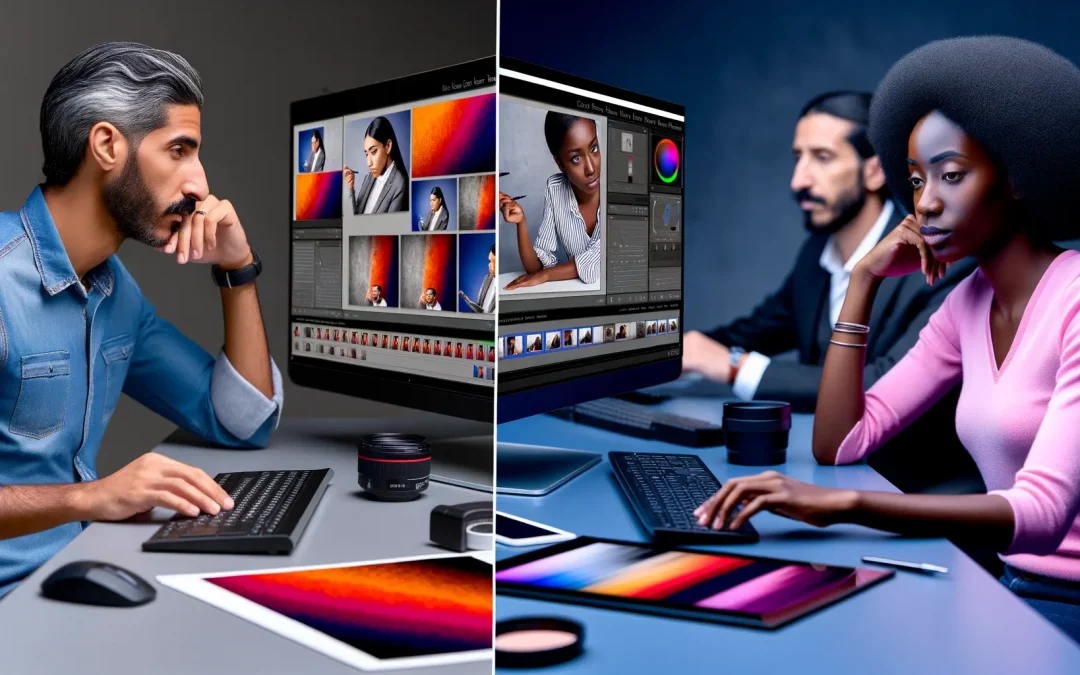Discover the nuances between editing and retouching in photography. Learn how these subtle distinctions can enhance your work and leverage new trends.
Defining Editing in Photography
Editing is the backbone of photography.
When you snap a picture, it’s raw, filled with possibilities yet unpolished. Editing is the process that bridges potential to perfection, laying the foundation for any image that follows. At its core, editing involves a range of technical refinements — the tapping and tweaking that can transform a photograph from basic to brilliant. Imagine adjusting colours to evoke specific moods, the warmth of a sunset enhanced with a few strokes. It’s not just about accuracy, though, there’s artistry at play too. Remember, even minor colour shifts engage emotions in profound ways.
Cropping, another essential component, focuses attention. It’s curious how merely trimming a scene can add layers of meaning. Have you ever found that cutting out the clutter sharpens the story you want to tell? The frame tightens to what truly matters, bringing balance and intent. Exposure adjustments as well, subtly darken areas to inject drama or lighten corners creating whispery softness, a dance of light and shadow that guides the viewer’s journey through the photograph.
Why is this initial phase crucial? It’s here that images breathe and prepare for the myriad paths they might take, from social media posts to printed art. If editing feels like crafting, well, it kind of is. Familiarity with tools like Adobe Lightroom can fine-tune this skill set. Industry trends fluctuate swiftly, so keeping up-to-date ensures outcomes remain captivating. When you spend time getting just right, your photos are ready for any platform, equipped to impress at exhibitions or on Instagram.
Editing is the art of seeing what could be, amplifying the best of what is. Anyone who’s yearned to take better travel photos, this is your playground. It’s that first, vital step where a photographer starts crafting their masterpiece.
Unpacking the Art of Retouching
Retouching is an art form in photography.
It’s all about fine-tuning the finer points to create perfectly polished images. Think of blemish removal, like a magic eraser smoothing out those blemishes that, let’s face it, are inevitable but not necessarily wanted in photos. Skin smoothing, well, that’s almost like a second skin, giving everyone that flawless glow.
Retouching hones in on aesthetics. It isn’t the same as editing which touches on colours or exposure; it digs deeper. This is where imperfections are erased, enhancing nuances to uplift the overall look. The difference, you ask? Editing sets the stage, and retouching brings the drama to life, almost like the final flourish of a masterpiece.
There’s a wide array of tools geared towards this craft. Have you ever tried using Adobe Photoshop for these adjustments? It’s quite user-friendly once you get the hang of it. From the initial quick fixes to more advanced refinements, retouching pulls everything together. And with some practice, even the subtleties can be finessed with ease.
You might wonder, can these skills really elevate work to a professional level? Absolutely. By mastering retouching, images transition into commercial-worth assets. Commercial photographers, they often find themselves judged by their finesse in retouching.
Perhaps you haven’t thought of it like this before, but taking a photo is just the beginning. Refining features, softening shadows, and really bringing out the eyes, these steps set the pros apart from the enthusiasts.
Still, the blend of subtlety and precision needed for retouching might be challenging. For tips that dive deep into techniques, check this guide. I think it’s a process of perfecting, more than changing. It’s the delicate finishing touch that turns images into magic.
Leveraging Trends and Techniques
Embracing trends and honing techniques can make a significant difference for photographers. It might seem like a daunting task, but mastering the art of editing and retouching through these avenues is achievable.
Staying on top of what’s ‘in’ right now means keeping an eye out for emerging tools and methods that can enhance your workflow. Take Adobe Lightroom, for instance. Its AI-driven editing tools offer smart adjustments that can speed up your process without sacrificing quality. But is it enough to just have the right tools? Sometimes, I wonder if we need to go deeper than what technology can offer. Maybe you need to develop a personal style that embraces both editing and retouching.
I’ve seen photographers get excited about the latest trends, only to realise they’ve overlooked the basics. Leveraging these trends means applying them thoughtfully rather than just following the crowd. Are your photos benefiting from HDR? Or perhaps experimenting with colour grading gives your work a unique edge. The latest tools can bring out nuances in your images, but without understanding their use, you might fall into traps of over-editing. Sometimes less is more, I guess.
And what about the gear that complements all this digital wizardry? High-resolution monitors and graphic tablets with pressure-sensitive pens allow for precision editing and retouching that’s pretty impressive. But does everyone need to rush out and buy the latest tech? Perhaps not immediately. The key is finding what enhances *your* workflow rather than just emptying your wallet.
For those looking to improve, online resources can be a lifeline. But what better way than collaborating with experts who understand the subtleties of editing and retouching? If you’re feeling a bit stuck, I’d suggest reaching out to seasoned professionals. Even a brief interaction might open doors you didn’t realise were closed.
To gain more insights, or if you need personalised guidance, consider contacting an expert like Alex Smale. With seasoned experience in photography learning, they can provide tailored advice. It might just be the nudge you need to elevate your craft.
Final words
Editing and retouching are vital skills for photographers aiming for breathtaking results. By understanding their differences and embracing the latest trends and techniques, photographers can significantly enhance the quality of their work and stay ahead in the field.

